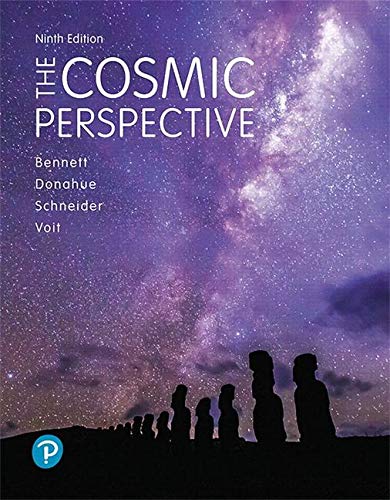
The Cosmic Perspective (9th Edition)
9th Edition
ISBN: 9780134874364
Author: Jeffrey O. Bennett, Megan O. Donahue, Nicholas Schneider, Mark Voit
Publisher: PEARSON
expand_more
expand_more
format_list_bulleted
Concept explainers
Question
Chapter S2, Problem 56EAP
To determine
The time taken by light to cross 100 meters.
Expert Solution & Answer
Want to see the full answer?
Check out a sample textbook solution
Students have asked these similar questions
A piece of metal is placed on top of a 2.0 - kg wooden block (mass density = 562 kg/m³) piece. UseArchimedes' principle to calculate the mass (in kg) of copper if the top of the wood surface is exactly at thewater's surface?
A filmmaker wants to achieve an interesting visual effect by filming a scene through a converging lens with a
focal length of 50.0 m. The lens is placed betwen the camera and a horse, which canters toward the camera
at a constant speed of 7.9 m/s. The camera starts rolling when the horse is 36.0 m from the lens. Find the
average speed of the image of the horse (a) during the first 2.0 s after the camera starts rolling and (b)
during the following 2.0 s.
Answer the question (Physics)
Chapter S2 Solutions
The Cosmic Perspective (9th Edition)
Ch. S2 - Prob. 1EAPCh. S2 - Prob. 2EAPCh. S2 - Prob. 3EAPCh. S2 - Prob. 4EAPCh. S2 - Prob. 5EAPCh. S2 - Suppose you see a friend moving by you at some...Ch. S2 - Prob. 7EAPCh. S2 - Prob. 8EAPCh. S2 - Prob. 9EAPCh. S2 - Prob. 10EAP
Ch. S2 - 11. What is mass increase? How does the mass of an...Ch. S2 - Prob. 12EAPCh. S2 - Prob. 13EAPCh. S2 - Prob. 14EAPCh. S2 - Prob. 15EAPCh. S2 - Prob. 16EAPCh. S2 - Prob. 17EAPCh. S2 - Prob. 18EAPCh. S2 - Prob. 19EAPCh. S2 - Prob. 20EAPCh. S2 - Prob. 21EAPCh. S2 - Prob. 22EAPCh. S2 - Prob. 23EAPCh. S2 - Does It Make Sense? Decide whether the statement...Ch. S2 - Does It Make Sense? Decide whether the statement...Ch. S2 - Prob. 26EAPCh. S2 - Prob. 27EAPCh. S2 - Prob. 28EAPCh. S2 - Prob. 29EAPCh. S2 - Prob. 30EAPCh. S2 - Choose the best answer to each of the following....Ch. S2 - Prob. 32EAPCh. S2 - Prob. 33EAPCh. S2 - 34. What provides the strongest evidence that...Ch. S2 - Prob. 35EAPCh. S2 - Prob. 36EAPCh. S2 - Prob. 38EAPCh. S2 - Prob. 39EAPCh. S2 - Prob. 40EAPCh. S2 - Prob. 42EAPCh. S2 - Prob. 43EAPCh. S2 - Prob. 44EAPCh. S2 - Relative Motion Practice II. In all the following,...Ch. S2 - Prob. 46EAPCh. S2 - Prob. 47EAPCh. S2 - Prob. 48EAPCh. S2 - Prob. 49EAPCh. S2 - Time Dilation. A student, after learning about the...Ch. S2 - Length Contraction. Marta has a spaceship that...Ch. S2 - Mass Increase. A spaceship has a rest mass of...Ch. S2 - Time Dilation with Subatomic Particles. A + meson...Ch. S2 - Time Dilation on the Space Station. The...Ch. S2 - Prob. 56EAPCh. S2 - Racing a Light Beam II. Following his humiliation...
Knowledge Booster
Learn more about
Need a deep-dive on the concept behind this application? Look no further. Learn more about this topic, physics and related others by exploring similar questions and additional content below.Similar questions
- Hi! I need help with these calculations for part i and part k for a physics Diffraction Lab. We used a slit width 0.4 mm to measure our pattern.arrow_forwardExamine the data and % error values in Data Table 3 where the angular displacement of the simple pendulum decreased but the mass of the pendulum bob and the length of the pendulum remained constant. Describe whether or not your data shows that the period of the pendulum depends on the angular displacement of the pendulum bob, to within a reasonable percent error.arrow_forwardIn addition to the anyalysis of the graph, show mathematically that the slope of that line is 2π/√g . Using the slope of your line calculate the value of g and compare it to 9.8.arrow_forward
- An object is placed 24.1 cm to the left of a diverging lens (f = -6.51 cm). A concave mirror (f= 14.8 cm) is placed 30.2 cm to the right of the lens to form an image of the first image formed by the lens. Find the final image distance, measured relative to the mirror. (b) Is the final image real or virtual? (c) Is the final image upright or inverted with respect to the original object?arrow_forwardConcept Simulation 26.4 provides the option of exploring the ray diagram that applies to this problem. The distance between an object and its image formed by a diverging lens is 5.90 cm. The focal length of the lens is -2.60 cm. Find (a) the image distance and (b) the object distance.arrow_forwardPls help ASAParrow_forward
arrow_back_ios
SEE MORE QUESTIONS
arrow_forward_ios
Recommended textbooks for you
 Physics for Scientists and Engineers: Foundations...PhysicsISBN:9781133939146Author:Katz, Debora M.Publisher:Cengage Learning
Physics for Scientists and Engineers: Foundations...PhysicsISBN:9781133939146Author:Katz, Debora M.Publisher:Cengage Learning College PhysicsPhysicsISBN:9781938168000Author:Paul Peter Urone, Roger HinrichsPublisher:OpenStax College
College PhysicsPhysicsISBN:9781938168000Author:Paul Peter Urone, Roger HinrichsPublisher:OpenStax College
 University Physics Volume 1PhysicsISBN:9781938168277Author:William Moebs, Samuel J. Ling, Jeff SannyPublisher:OpenStax - Rice University
University Physics Volume 1PhysicsISBN:9781938168277Author:William Moebs, Samuel J. Ling, Jeff SannyPublisher:OpenStax - Rice University College PhysicsPhysicsISBN:9781285737027Author:Raymond A. Serway, Chris VuillePublisher:Cengage Learning
College PhysicsPhysicsISBN:9781285737027Author:Raymond A. Serway, Chris VuillePublisher:Cengage Learning Foundations of Astronomy (MindTap Course List)PhysicsISBN:9781337399920Author:Michael A. Seeds, Dana BackmanPublisher:Cengage Learning
Foundations of Astronomy (MindTap Course List)PhysicsISBN:9781337399920Author:Michael A. Seeds, Dana BackmanPublisher:Cengage Learning

Physics for Scientists and Engineers: Foundations...
Physics
ISBN:9781133939146
Author:Katz, Debora M.
Publisher:Cengage Learning

College Physics
Physics
ISBN:9781938168000
Author:Paul Peter Urone, Roger Hinrichs
Publisher:OpenStax College


University Physics Volume 1
Physics
ISBN:9781938168277
Author:William Moebs, Samuel J. Ling, Jeff Sanny
Publisher:OpenStax - Rice University

College Physics
Physics
ISBN:9781285737027
Author:Raymond A. Serway, Chris Vuille
Publisher:Cengage Learning

Foundations of Astronomy (MindTap Course List)
Physics
ISBN:9781337399920
Author:Michael A. Seeds, Dana Backman
Publisher:Cengage Learning